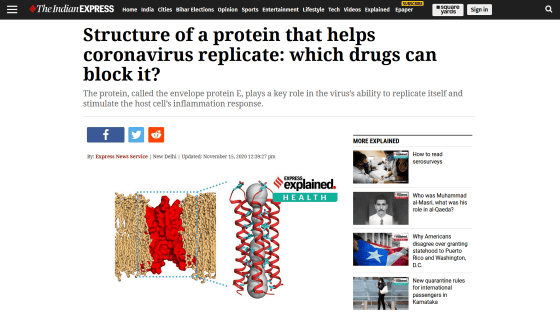Possibility to be a target for new therapeutic agents that identify important protein structures of the new coronavirus

A research team at the Massachusetts Institute of Technology (MIT) has identified the structure of a protein called ' envelope protein E ' in the new coronavirus (SARS-CoV-2), which continues to spread around the world. Envelope protein E is said to play an important role in SARS-CoV-2 replicating itself and stimulating the inflammatory response of infected cells, and drugs targeting this protein are the new coronavirus infection ( The research team states that it may be useful in the treatment of COVID-19).
Structure and drug binding of the SARS-CoV-2 envelope protein transmembrane domain in lipid bilayers | Nature Structural & Molecular Biology
Chemists discover the structure of a key coronavirus protein | MIT News | Massachusetts Institute of Technology
https://news.mit.edu/2020/chemists-discover-structure-key-coronavirus-protein-1112
Structure of a protein that helps coronavirus replicated: which drugs can block it? | Explained News, The Indian Express
https://indianexpress.com/article/explained/structure-of-a-protein-that-helps-coronavirus-replicate-which-drugs-can-block-it/

The laboratory of Professor May Hong of MIT, the lead author of the paper, specializes in the study of protein structures embedded in cell membranes. It seems that it is difficult to analyze the protein embedded in the cell membrane due to the influence of the lipid bilayer , which is the basic structure of the cell membrane, but Hong et al. Have a method to analyze the protein structure using nuclear magnetic resonance spectroscopy. Has been developed in the past .
Following the SARS-CoV-2 pandemic in 2020, Hong's research team began researching the protein structure of SARS-CoV-2. Mr. Hong decided to focus on the envelope protein E of SARS-CoV-2 because it is similar to the M2 protein on the surface of the influenza virus that he had previously studied .
'After a year and a half of hard work, we have determined the structure of the M2 protein in influenza B virus,' said Hong. He explained that in his research on influenza virus, he had already obtained the know-how to clone and purify viral membrane proteins and analyze them by nuclear magnetic resonance spectroscopy.
Envelope protein E, like M2 protein, is composed of a bundle of spiral proteins and functions as an ion channel that passively permeates ions . Envelope protein E seems to play an important role in the ability to stimulate SARS-CoV-2 replication and the inflammatory response of cells.

The research team, which cloned and purified the envelope protein E of SARS-CoV-2 in two and a half months, embedded the envelope protein E in a lipid bilayer and analyzed it by nuclear magnetic resonance spectroscopy. The research team continued to analyze envelope protein E non-stop for about two months using multiple devices, including a state-of-the-art nuclear magnetic resonance device at MIT.
As a result, it was found that a part of the envelope protein E was gathered in a spiral bundle of five, and this part formed a tight ion channel. Amino acids that may attract calcium ions and the like have also been identified at one end of the ion channel, and the state observed by the research team is thought to be the state in which the ion channel is closed. The opening and closing of this ion channel is thought to affect the function of SARS-CoV-2, and the research team hopes to identify the structure of the open ion channel in future research.
The researchers also found that amantadine , a treatment for influenza, and hexamethylene amiloride , a treatment for hypertension, may block the ion channels of envelope protein E. However, because these drugs have weak binding to envelope protein E, the development of stronger inhibitors may help treat COVID-19.
Hong pointed out that basic scientific research can make an important contribution to solving medical problems. 'It is important to recognize and remember that our society needs to continue its basic scientific research on viral or bacterial proteins even after the pandemic is over. But the human and economic costs of not doing research are too great, ”said Hong.

Related Posts:
in Science, Posted by log1h_ik







